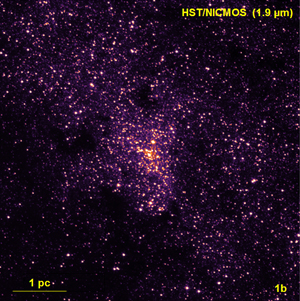Feb 1 2013
Cornell researchers have captured the sharpest mid-infrared images yet of a ring of gas and dust seven light-years wide orbiting the supermassive black hole at the center of the Milky Way.
 Hubble Space Telescope/NICMOS near-infrared image showing the same field of view with the same scale and orientation as the image above. At this wavelength, opaque dust in the plane of the Milky Way hides features that are seen in the SOFIA image. (NASA/STScI)
Hubble Space Telescope/NICMOS near-infrared image showing the same field of view with the same scale and orientation as the image above. At this wavelength, opaque dust in the plane of the Milky Way hides features that are seen in the SOFIA image. (NASA/STScI)
Thanks to images taken with a Cornell-built camera aboard an airborne observatory, the researchers have found that the material in the Circumnuclear Ring (CNR) is likely heated centrally by a massive cluster of hot, young stars, said Ryan Lau, a graduate student in the field of astronomy at Cornell. "We also don't see any evidence of star formation occurring within the CNR, which tells us the dust isn't quite dense enough to form stars. But it may become dense enough in the future," he said.
Lau presented his findings Jan. 8 during the American Astronomical Society's meeting in Long Beach, Calif. His co-author on the research is Terry Herter, professor and chair of Cornell's Department of Astronomy.
They and their colleagues are trying to learn about the extreme environment around the supermassive black hole, which has 4 million times the mass of the sun, in the center of our galaxy, Lau said. The highest-resolution mid-infrared images yet of the inner 20 light-years of the galaxy have allowed Lau and his colleagues to study the structure of the CNR in great detail.
"Since we have such high-resolution images we can measure the width of the CNR and study the small 'clumps' -- or the darker regions in our infrared images -- that appear along the inner edge of the ring. One of the questions we're trying to address is, should we expect to see the same thing if we look at that region a million years from now? Is it a transient feature?"
Lau and his colleagues are in the process of completing the analysis on their data, looking at what CNR's "clumpiness" tells them about the influence of the supermassive black hole.
The images were taken during two flights in 2011 with a Cornell-built camera aboard a highly modified Boeing 747SP aircraft. The airborne observatory is called the Stratospheric Observatory for Infrared Astronomy (SOFIA), which carries a telescope with an effective diameter of 100 inches to altitudes as high as 45,000 feet. The telescope is fitted with an infrared camera, FORCAST (Faint Object InfraRed Camera for the SOFIA Telescope), built by Herter and the FORCAST team.
FORCAST offers astronomers the ability to see CNR and other exotic cosmic features whose light is obscured by water vapor in Earth's atmosphere and interstellar dust clouds in the mid-plane of the Milky Way. Neither ground-based observatories on tall mountain peaks nor NASA's orbiting Hubble Space Telescopes can see them. While the Spitzer Space Telescope can see the CNR and capture images of it, the FORCAST shots have better resolution at 24 microns. Each FORCAST image is a combination of multiple exposures at wavelengths of 20, 32 and 37 microns.
The combination of SOFIA's airborne telescope with the FORCAST camera produced the sharpest images of those regions ever obtained at mid-infrared wavelengths, allowing discernment of new clues about what is happening near the central black hole.
"One of the reasons why these studies of the center of our galaxy are so important is that they can potentially tell us about the environment and conditions in the centers of other galaxies around their supermassive black holes," Lau said.
NASA's Ames Research Center in Moffett Field, Calif., manages the SOFIA science and mission operations in cooperation with the Universities Space Research Association headquartered in Columbia, Md., and the German SOFIA Institute at the University of Stuttgart.